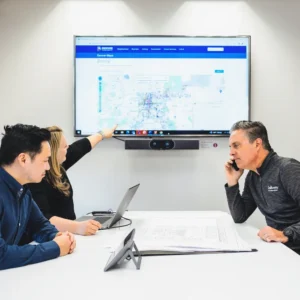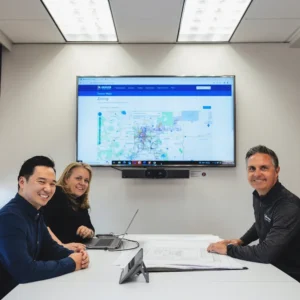Determining and adhering to a schedule is crucial when developing a project. However, a commonly underestimated scheduling aspect is the permitting and entitlement preparation and approval process. Galloway understands the importance of creating a realistic schedule to ensure efficiency and cost-effectiveness. Our development services team was recently hired to help clients maintain their schedules and go through the easement process.
The Situation
At a glance, the project seemed uncomplicated. It involved remodeling a building and reconfiguring the parking lot. The client had conducted upfront due diligence with the building department and local fire reviewing company. Still, upon further research, our development services team discovered additional aspects that would affect the original schedule.
The original schedule was based on a similar project the client had done in Utah. The client was allotted 30 days to prepare and approve the permitting process. However, the Utah process was not comparable to the process in Colorado.
Galloway’s Due Diligence
Galloway’s development services team first met with the city for a pre-application meeting. Construction documents mustn’t be prepared without knowing if the city will allow your design to be built. This avoids wasting valuable time and money to complete construction documents and have them denied or require major rectifications.
“We met with the city to ensure there were no red flags and to understand what the process would look like so we could give our client a realistic schedule,” said Nate Abbott, senior development services project manager and senior associate at Galloway.
This pre-application meeting is where Galloway’s team discussed the need for a change in use permit due to the site comprising two parcels with two different zoning designations. They then told the client that this required an amendment to the site plan.
Galloway also communicated that rectifying the grading, subsequent drainage, and the street improvements required working with reviewing authorities Denver Water and the Colorado Department of Transportation (CDOT). In addition to working with reviewing authorities, Galloway scoped the property appropriately and found that the original survey for the project did not include the necessary data required for grading and street improvements, and the surveying had to be redone. The original schedule did not account for all of this.
The client was informed of the new process and project schedule. Instead of an August turnover, construction would start in October.
“What the client thought was initially a two-month loss could have turned into six months later,” said Abbott when explaining the significance of this due diligence process.
“It is all about understanding risks and the impact on the project to the timeline as well as financial ramifications,” he added. “We put ourselves in our client’s shoes and spend the money like ours. We ask for more information. Sometimes, the city will ask for a long list of things that add to the scope and cost for the client. We don’t accept things at face value, but still do our due diligence, stay ethical, and look out for the client.”
Development of Solutions
Galloway’s team was initially brought on to help with permitting and easements. However, they ended up following through with the project without an easement.
“Sometimes our value is not in what we add, but what we can subtract from their scope,” said Abbott. “We worked closely with their land use attorney to determine whether we had to vacate that easement and how it impacted the other property owner.”
In addition, the project did not have to go through a planning commission hearing because Galloway knew the codes were being changed, which meant a public hearing was not required for this type of application. The team conducted a risk-benefit analysis that determined it was worth adding two weeks to the timeline to have a clear shot to the finish rather than being held up in the planning commission.
“There were some education points along the way that our teammates could have with the reviewing authorities and the client that saved money for our client. It could have shut down the project if the planning commission did not approve it. So sometimes, while it may add to the timeline slightly, the client’s risk level significantly decreased,” said Abbott.
Galloway also took a full-spectrum approach to the project. Their transportation team conducted the transportation analysis for CDOT, their survey team redid the survey, their civil engineering team worked with Southeast Metro Stormwater authorities to determine the necessary drainage requirements, and their landscape architecture and photometric groups coordinated with the project architect.
“Because we have everything under one roof, we can easily discuss who is involved, the timeline, and the risk-benefit analysis. You are not bringing in another consultant and having to get them caught up on everything,” said Abbott.
 Resolution
Resolution
Galloway’s experience working across multiple jurisdictions and navigating the path of least resistance with all involved parties upfront has gained the trust of their clients to complete successful projects.
“We have worked across multiple jurisdictions and are good at figuring out the process no matter where it is,” said Abbott. It is important to clients to have someone who has proven their worth on a project and who they trust understands their end game.”
Due to Galloway’s work with this client, they are working on a similar second project in a different location.
“The client realized we helped them, and they got us involved this time with their second project.”
We are nationally recognized and locally preferred. We would love to work with you on your next project.
Contact Us